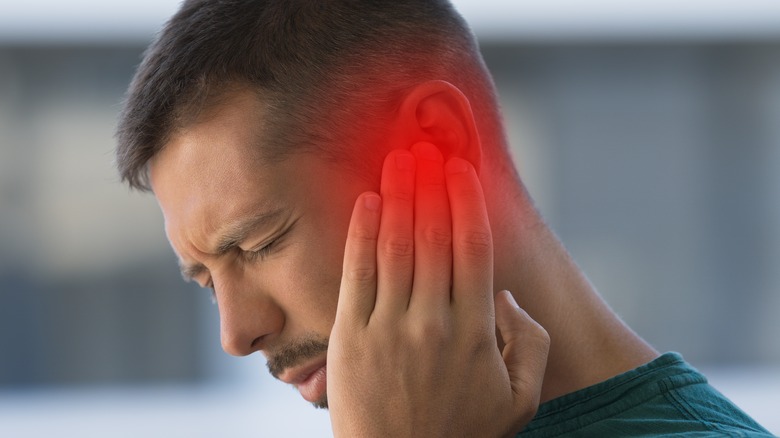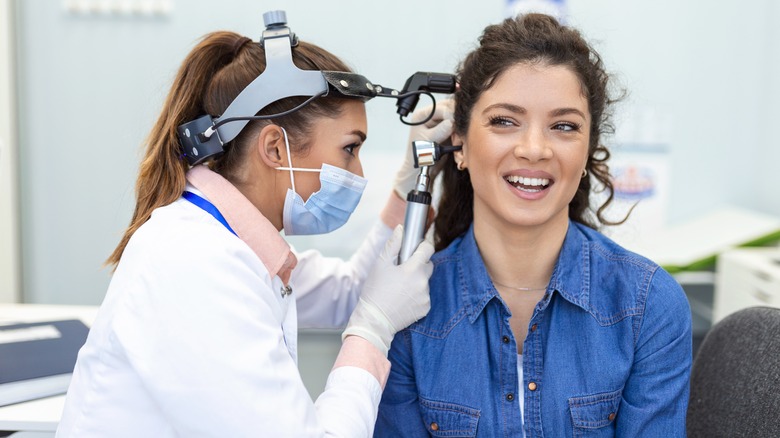What Causes Red Ear Syndrome
Red ear syndrome (RES) refers to a series of burning sensations and reddening of the external ear, as per a 2013 study published in The Journal of Headache and Pain. The condition has remained a mystery since it was first discovered in 1994. In fact, its prevalence is unknown, and it appears to be a rare disorder, with only about 100 published cases in the medical literature. Furthermore, opinions are divided about the classification and treatment of red ear syndrome, according to the American Academy of Dermatologists Association (AAD).
If your ears are red with a burning sensation, you might have the condition. While you may not want to see a doctor for mild symptoms, some scenarios require medical attention to rule out more serious conditions associated with red ears. Here's what you should know to get a better understanding of the causes and symptoms of red ear syndrome, when to see a doctor, and the available treatment options.
A possible cause of red ear syndrome
Since red ear syndrome is rare, the causes are still unclear (per WebMD). From what scientists understand, the condition comes in various forms. There are two main types — primary and secondary red ear syndrome. Primary red ear syndrome is commonly found in children and teenagers, whilst older adults are more likely to have the secondary form. Both forms come with their own distinctive symptoms.
One particularly interesting case of red ear syndrome was detailed in a 2014 study published in the Journal of Medical Case Reports. The study involved a 22-year-old patient with highly distressing episodes of redness in the ears, intolerance to noise, and burning pain around temporal areas. After keeping a food diary, the patient recognized orange juice and stress as her main triggers. Nevertheless, this was the first case in which red ear syndrome was found to be triggered by orange juice.
Symptoms of red ear syndrome
The symptoms of red ear syndrome (RES) vary depending on the type. In a 2013 study published in The Journal of Headache and Pain, the primary level of red ear syndrome is associated with migraines. In contrast, secondary RES cases may come with more severe conditions, like upper cervical spine disorders or joint dysfunction. While the condition is mainly characterized by a more pronounced reddening of the external ear or earlobe, the burning pain and redness can extend to the temple and upper neck.
In a 2022 study published in the journal Clinical Case Reports, symptoms can occur out of nowhere or be brought on by coughing, stress, neck movements, chewing, and brushing of the hair. According to WebMD, you might notice one or both of your ear lobes becoming red, accompanied by a burning sensation. The burning might feel like mild throbbing for some people, while others experience more severe pain, spreading from the ear lobes to the cheeks, jaw, or the back of the head. Those who develop the condition usually experience symptoms during the daytime, with a typical attack lasting between 30 and 60 minutes and sometimes even as long as four hours.
When to see a doctor
Due to the fluidity of the symptoms associated with red ear syndrome, it's tempting to diagnose yourself. However, it would be best to visit your doctor first. This is especially important if your symptoms are accompanied by fever, swollen lymph nodes, shivers, and chills (per Healthline). Polychondritis, for example, could lead to some redness and discomfort in the ear. However, it can extend to other areas in the ear, like your inner ear, which may cause some hearing loss. Therefore, it's crucial to see your physician.
The pain associated with red ear syndrome can be another reason to visit your doctor. Although the intensity of the pain episodes hasn't been properly studied, severe pain has been reported, although rare, according to a 2013 study published in the Journal of Headache and Pain. In fact, the level of pain has been more or less described as an annoying discomfort rather than excruciating. For the most part, however, your symptoms might not be severe since complications are uncommon, just like the condition itself.
How red ear syndrome is diagnosed
Since the exact cause of red ear syndrome is unknown, your doctor might have to conduct various tests to rule out other conditions. The criteria to diagnose red ear syndrome were proposed in 2013, according to the 2022 study published in the journal Clinical Case Reports. The criteria demand that you must have experienced about 20 attacks of pain and abnormal redness of your ears lasting for four hours. Therefore, your doctor might check for this and conclude your diagnosis after ruling out other serious medical conditions in the brain linked to intracranial and extracranial pathology.
Examples of intracranial pathology include hemorrhage, cerebral edema, tumor, abscess, and ischemic stroke, per this 2006 study published in the journal Blood. These conditions can be identified and confirmed by a head CT scan during the diagnosis of red ear syndrome. On the other hand, examples of extracranial pathology include facial paralysis, subperiosteal abscess, and labynnthitis, as per a 2007 study published in The Journal of Laryngology & Otology.
How to treat red ear syndrome
Unfortunately, symptoms of red ear syndrome are usually stubborn to medical treatments, according to the American Academy of Dermatology Association (AAD). However, some migraine-preventative medications, like propranolol, might come with moderate benefits. Other listed treatment options include oral tricyclic antidepressants, topical anesthetics, and gabapentin.
In a 2014 study published in the Journal of Medical Case Reports, experts noticed that in one patient methysergide therapy enhanced her condition. In others, some relief came after taking indomethacin. This reduced pain symptoms for more than 8 weeks. After all, triggers have been brought on by a variety of things, such as walking into a hot room, by touching, and neck movement, among others. However, as for non-medicated therapeutic options, physically cooling the skin might also offer some form of relief.
As there's no specific diagnostic test to confirm what triggers the condition, making lifestyle modifications and making a note of certain triggers to avoid might help reduce the risk of red ear syndrome.






